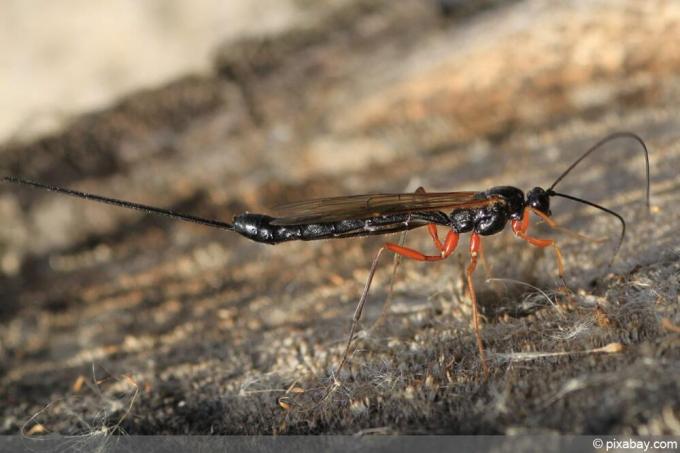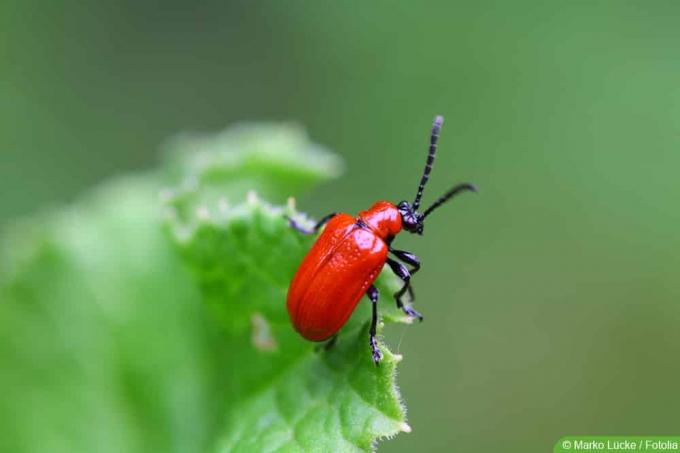

Table of contents
- appearance
- life cycle
- symptoms of infestation
- Natural sprays
- SF nematodes
- Trichogramma parasitic wasps
- Bacillus thuringiensis is ineffective
- prevention
Plum moths have several types of stone fruit in their sights. It is the voracious caterpillars that destroy all hopes of juicy fruit. The earlier you diagnose an infestation, the more effectively you can fight it. Read this guide to find out what symptoms point to the pests. These 2 insecticides and natural sprays are approved and tried and tested in the home garden. How to fight plum moth properly.
appearance
Plum moths (Grapholita funebrana) belong to the butterflies. Although it's the caterpillars that can cause massive damage to your fruit trees, you should be familiar with the identifying features of adult moths. The earlier you recognize an infestation, the more successful the fight will be. These attributes characterize plum moth moths:
- Body length: 7 to 8 mm
- Wing span: 11 to 15 mm
- Coloration of forewings: dull lilac to greyish
- Coloration hind wings: dark gray to grey-brown
- Differences between male and female moths: none available
The caterpillars, which are initially white, turn pink to crimson with a dark brown head as they develop. With a length of 10 to 15 millimeters, the larvae are easy to spot with the naked eye. Finding adult plum moths is more difficult because the butterflies are nocturnal.
life cycle
At the end of April, the moths hatch from their pupation. Under normal weather conditions, the pests produce two generations per year. Under ideal conditions even three attack waves. From the end of April/beginning of May, females of the first generation lay 40 to 60 eggs directly on the stalks of young fruits. Hatched caterpillars immediately burrow into the fruit, where they develop into adult caterpillars within four weeks. Affected fruits fall off prematurely.
The second generation also causes massive harvest losses. These moths hatch from July and fly well into September. Their larvae bore in immediately and begin feeding on their maturation. Together with the destroyed fruit, the caterpillars drop to the ground or abseil down with delicate silk threads. As a rule, both generations overlap, so that there is a simultaneous moth flight with a correspondingly high infestation pressure.
For pupation, the caterpillars form webs on moss-covered tree trunks and branches or between pieces of bark. You are welcome to choose dead wood, bark or wood mulch on the garden floor for the process. The spun-in larvae hibernate in it in order to hatch on time the following year.
symptoms of infestation

As nocturnal moths, adult plum moths have a good chance of evading your attention. To catch the pest infestation early, keep an eye out for these symptoms of the presence of caterpillars:
- Purple colored, soft fruits
- Not ripening and premature fruit drop
- 2 mm small drilling holes on the underside of the fruit with colorless drops
If you cut open an affected fruit, you can see fine mining tunnels in it. The maggot is often still inside the plum. If a caterpillar has already finished feeding on its ripening and left the fruit, the flesh of the fruit is covered with dark deposits of faeces.
Natural sprays
An infestation with plum moths means immediate action for orchards. Immediately remove any infected fruit. Please do not throw these in the compost, but in the garbage can. Alternatively, you can hand in the fallen fruit at the municipal composting facility. After the immediate measure, fight the remaining pests in the garden with a natural spray or insecticide. The following preparations are currently approved for use in the home garden:
SF nematodes
The tiny, 8 mm long roundworms of the Steinernema species have proven to be an effective and natural method of combating plum moths for many years. When the caterpillars hide behind the bark or in pieces of wood on the ground, the beneficial insects are applied as a spray solution. The nematodes parasitize the caterpillars and thus kill the pests. It is important to note that the nozzle of the pressure sprayer is larger than 8 mm and works with a maximum pressure of 2.5 bar. Alternatively, spread the liquid insecticide with the watering can. The package leaflet provides information on dosage.
- Best time for application: September and October
- If necessary, apply additionally in spring: May and June
- price for 6 million Nematodes, enough for 6 small or 3 large trees: from 15 euros
Trichogramma parasitic wasps

Ichneumon wasps parasitize plum moth eggs. The beneficial insects have therefore proven to be a valuable protective aid for gardeners to successfully control the pests in the early stages in a natural way. So far, parasitic wasps have been placed on cards in the garden. The application as a sprayable mixture is in the experimental stage. You will receive the winged beneficial insects as pupae in partial deliveries three weeks apart. Gradually, the wasps hatch and hunt for the freshly laid eggs of plum moths. Success is only guaranteed if you do not use chemical insecticides in the garden for at least six weeks before and after.
- Best dates for application: 21. June and 1 July
- One to two weeks later for late-ripening fruit varieties
- Price for 3 x 4 cards, each with 3,000 dolls: from 29.90 euros
Bacillus thuringiensis is ineffective
To control plum moth caterpillars, approved products based on Bacillus thuringiensis are largely useless. The effectiveness is based primarily on the fact that caterpillars eat a sufficiently large amount of the spray. In the organism, the bacterium then produces toxins in the stomach and intestines, which immediately stop eating. Sensitive larvae die within five days. At least the fertility is reduced on older caterpillars. This control strategy comes to nothing on plum moth caterpillars. Immediately after hatching, a larva bores into the fruit. Unlike many other caterpillar pests, it does not wander around on leaves or fruit skin where it could ingest the insecticide.
Tip:
You can optimize the effectiveness of recommended spray agents with additional safety belts. At the end of July, wrap the trunks of threatened trees at a height of 20 to 40 centimetres, for example with the Neudorff fruit maggot catch belt. The bio-engineered and completely non-toxic construction deters caterpillars from crawling up the trunk to hibernate in the crown. A particular advantage of this control strategy is that it is harmless to beneficial insects.
prevention
You can control and reduce the infestation pressure even while the moth is in flight. This can be done with pheromone traps. These are designed as sticky traps and emit a scent that irresistibly attracts male plum moths. In the hope of meeting a female, the males fly into the trap. There they stick hopelessly to the three-sided glue. In this way fewer female moths are mated. Furthermore, the catch rate provides a good overview of the number of pests in your garden and gives an indication of whether you should use an insecticide.
A single trap is enough to protect up to three trees from plum moths for a season. All well-known manufacturers of plant protection products offer the traps under different product names, like Plum Maggot Trap (Compo), Plum Maggot Trap System (Substral) or Neudomon Plum Maggot Trap (Neudorff). The unit price is around 6 euros.
 garden editorial
garden editorial I write about everything that interests me in my garden.
Learn more about plant pests

White spots on leaves: what to do?
Whether in the home or in the garden, white spots on the leaves of your favorite plants are always a cause for concern. However, the causes can often be eliminated quickly. This guide summarizes the most common triggers and gives tips for quick help.

Cherry laurel has yellow eaten leaves: what to do?
Despite the robust nature of Prunus laurocerasus, it is occasionally attacked by pests and fungi. An infestation can be recognized by feeding damage and the discoloration of the leaves to yellow. You can find out how to combat and prevent the accumulation here.

Fighting grubs | Protect raised bed & lawn
Larvae of various species of beetles, grubs, can do a lot of damage in the garden. They live in the ground for several years and prefer to feed on roots. We present effective methods to combat the voracious pest or to effectively prevent an infestation.

Worms in cherries - 8 tips against maggots in cherries?
Worms in sweet cherries can spoil your appetite. It is a major nuisance when the entire cherry crop is affected. With these tricks you can contain the pest infestation and ensure that the insects do not multiply any further.

Fighting lily beetle - 11 effective home remedies
Lilies in the garden are beautiful to look at. There are the greatest types and varieties, all of which somehow have something special. Lily lovers can draw from the abundance of offers and look forward to the floral splendor. Lilies are actually quite hardy. There are few diseases and pests that can cause damage. However, the lily chicken can spoil the splendor.

Combating fungal infestation on trees: how to remove tree fungi
A tree fungus does not appear threatening, sometimes it is even interesting to look at. But that is deceptive. What we see is only the fruiting body, the mycelium is deep in the wood and destroys it slowly but purposefully. Eventually it kills the strongest tree.
